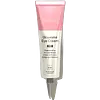What's inside
What's inside
 Key Ingredients
Key Ingredients

 Benefits
Benefits

 Concerns
Concerns

No concerns
 Ingredients Side-by-side
Ingredients Side-by-side

Water
Skin ConditioningUrea
BufferingGlycerin
HumectantBacillus Ferment
Skin ConditioningCetyl Alcohol
EmollientGlyceryl Stearate
EmollientCoco-Caprylate
EmollientTocopherol
AntioxidantSodium Ascorbyl Phosphate
AntioxidantHexylresorcinol
AntimicrobialSodium Anisate
AntimicrobialSodium Levulinate
Skin ConditioningLactic Acid
BufferingSclerotium Gum
Emulsion StabilisingXanthan Gum
EmulsifyingCetyl Hydroxyethylcellulose
Emulsion StabilisingGlyceryl Caprylate
EmollientFerulic Acid
AntimicrobialSimmondsia Chinensis Seed Oil
EmollientOryza Sativa Bran Oil
EmollientDalea Spinosa Seed Oil
MaskingSodium Phytate
Caprylyl Glycol
EmollientHibiscus Sabdariffa Flower Extract
Skin ConditioningSambucus Nigra Flower Extract
RefreshingGinkgo Biloba Leaf Extract
Skin ConditioningPalmitoyl Proline
Skin ConditioningTripeptide-5
Skin ConditioningAcetyl Hexapeptide-8
HumectantWater, Urea, Glycerin, Bacillus Ferment, Cetyl Alcohol, Glyceryl Stearate, Coco-Caprylate, Tocopherol, Sodium Ascorbyl Phosphate, Hexylresorcinol, Sodium Anisate, Sodium Levulinate, Lactic Acid, Sclerotium Gum, Xanthan Gum, Cetyl Hydroxyethylcellulose, Glyceryl Caprylate, Ferulic Acid, Simmondsia Chinensis Seed Oil, Oryza Sativa Bran Oil, Dalea Spinosa Seed Oil, Sodium Phytate, Caprylyl Glycol, Hibiscus Sabdariffa Flower Extract, Sambucus Nigra Flower Extract, Ginkgo Biloba Leaf Extract, Palmitoyl Proline, Tripeptide-5, Acetyl Hexapeptide-8
Oryza Sativa Bran Water
MaskingRice Ferment Filtrate
Skin ConditioningButylene Glycol
HumectantCaprylic/Capric Triglyceride
MaskingSqualane
EmollientBehenyl Alcohol
EmollientBifida Ferment Filtrate
Skin Conditioning1,2-Hexanediol
Skin ConditioningLactobacillus/Soybean Ferment Extract
Skin ConditioningNiacinamide
SmoothingAmmonium Acryloyldimethyltaurate/Vp Copolymer
Ceramide NP
Skin ConditioningGalactomyces Ferment Filtrate
HumectantWater
Skin ConditioningMadecassoside
AntioxidantBeta-Glucan
Skin ConditioningCentella Asiatica Extract
CleansingPanax Ginseng Root Water
MaskingAdenosine
Skin ConditioningSynthetic Beeswax
Emulsion StabilisingSaccharum Officinarum Extract
MoisturisingNymphaea Caerulea Flower Extract
Skin ConditioningGlycerin
HumectantTocopherol
AntioxidantPentylene Glycol
Skin ConditioningLevulinic Acid
PerfumingEthylhexylglycerin
Skin ConditioningOryza Sativa Bran Water, Rice Ferment Filtrate, Butylene Glycol, Caprylic/Capric Triglyceride, Squalane, Behenyl Alcohol, Bifida Ferment Filtrate, 1,2-Hexanediol, Lactobacillus/Soybean Ferment Extract, Niacinamide, Ammonium Acryloyldimethyltaurate/Vp Copolymer, Ceramide NP, Galactomyces Ferment Filtrate, Water, Madecassoside, Beta-Glucan, Centella Asiatica Extract, Panax Ginseng Root Water, Adenosine, Synthetic Beeswax, Saccharum Officinarum Extract, Nymphaea Caerulea Flower Extract, Glycerin, Tocopherol, Pentylene Glycol, Levulinic Acid, Ethylhexylglycerin
 Reviews
Reviews

Ingredients Explained
These ingredients are found in both products.
Ingredients higher up in an ingredient list are typically present in a larger amount.
Glycerin is already naturally found in your skin. It helps moisturize and protect your skin.
A study from 2016 found glycerin to be more effective as a humectant than AHAs and hyaluronic acid.
As a humectant, it helps the skin stay hydrated by pulling moisture to your skin. The low molecular weight of glycerin allows it to pull moisture into the deeper layers of your skin.
Hydrated skin improves your skin barrier; Your skin barrier helps protect against irritants and bacteria.
Glycerin has also been found to have antimicrobial and antiviral properties. Due to these properties, glycerin is often used in wound and burn treatments.
In cosmetics, glycerin is usually derived from plants such as soybean or palm. However, it can also be sourced from animals, such as tallow or animal fat.
This ingredient is organic, colorless, odorless, and non-toxic.
Glycerin is the name for this ingredient in American English. British English uses Glycerol/Glycerine.
Learn more about GlycerinTocopherol (also known as Vitamin E) is a common antioxidant used to help protect the skin from free-radicals and strengthen the skin barrier. It's also fat soluble - this means our skin is great at absorbing it.
Vitamin E also helps keep your natural skin lipids healthy. Your lipid skin barrier naturally consists of lipids, ceramides, and fatty acids. Vitamin E offers extra protection for your skin’s lipid barrier, keeping your skin healthy and nourished.
Another benefit is a bit of UV protection. Vitamin E helps reduce the damage caused by UVB rays. (It should not replace your sunscreen). Combining it with Vitamin C can decrease sunburned cells and hyperpigmentation after UV exposure.
You might have noticed Vitamin E + C often paired together. This is because it is great at stabilizing Vitamin C. Using the two together helps increase the effectiveness of both ingredients.
There are often claims that Vitamin E can reduce/prevent scarring, but these claims haven't been confirmed by scientific research.
Learn more about TocopherolWater. It's the most common cosmetic ingredient of all. You'll usually see it at the top of ingredient lists, meaning that it makes up the largest part of the product.
So why is it so popular? Water most often acts as a solvent - this means that it helps dissolve other ingredients into the formulation.
You'll also recognize water as that liquid we all need to stay alive. If you see this, drink a glass of water. Stay hydrated!
Learn more about Water